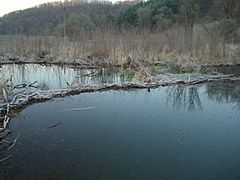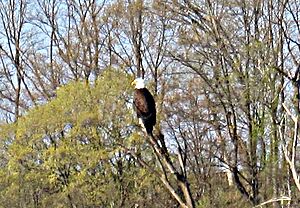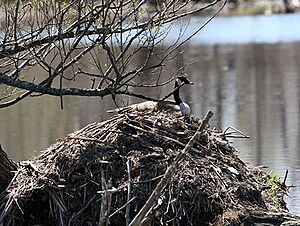Weister Creek facts for kids
Quick facts for kids Weister Creek |
|
|---|---|

Beaver Dam on Weister Creek, Wisconsin 2010
|
|
| Country | United States |
| State | Wisconsin |
| Region | Vernon County |
| Physical characteristics | |
| Main source | Vernon County Wisconsin, United States 1,200 ft (370 m) 43°41′42″N 90°42′29″W / 43.69500°N 90.70806°W |
| River mouth | Confluence with the Kickapoo River Vernon County, Wisconsin 810 ft (250 m) 43°37′15″N 90°37′39″W / 43.62083°N 90.62750°W |
Weister Creek is a cool stream, about 25 miles (40 kilometers) long. It flows through Vernon County in southwestern Wisconsin, United States. This creek is a smaller stream that flows into the Kickapoo River.
Weister Creek is special because it's in a place called the Driftless Area. This area has lots of hills and valleys. It looks like the huge glaciers from the last Ice Age (called the Pleistocene era) somehow missed it. A big part of the lower Weister Creek is surrounded by wet, marshy lands. This area is part of the Kickapoo Valley Reserve.
Contents
Exploring Weister Creek's Past
Early Explorers and Settlers
The story of people settling in this area goes way back to the 1600s. Two explorers, Jacques Marquette and Louis Jolliet, traveled by canoe down the Wisconsin River. They went to a busy fur trading post called Fort Crawford, which is now known as Prairie du Chien.
Later, a man named W. T. Sterling was one of the first white explorers to explore Vernon County. He came from Kentucky with his family and two other men. In 1832, they traveled from Madison to explore the Kickapoo River and its smaller streams.
The Ho-Chunk Nation and Land Changes
In the 1820s, the Ho-Chunk Nation, also known as the Winnebago, faced a big change. The government wanted to use the lead in their land. Because of this, the Ho-Chunk people were forced to move from their homes.
The Kickapoo Valley Reserve Story
The area known as the Kickapoo Valley Reserve almost became a huge lake called "Lake LaFarge." The Army Corps of Engineers planned to build a dam on the Kickapoo River. This dam was meant to help control floods.
However, environmental groups fought against the dam for 20 years, and the project was eventually stopped. Even though the dam wasn't built, the government had already bought land for it starting in 1969. About 140 farms were purchased from people who didn't really want to sell their land.
In 1996, a law was passed that officially stopped the dam project. Most of the land, about 8,569 acres (34.68 square kilometers), was given back to the State of Wisconsin. But a smaller part, about 1,200 acres (4.9 square kilometers), was given to the federal Bureau of Indian Affairs. This land is now held in trust for the Ho-Chunk Nation.
Land Use Around the Creek
Today, most of the wet, marshy lands (wetlands) around the Kickapoo River have been drained. They are now used for farming. Wetlands make up only a tiny part (0.8%) of the land around the river. Farming uses a lot of the land (50.4%), and forests cover almost as much (48%).
Amazing Animals and Plants of Weister Creek
Trout Fishing in Weister Creek

Weister Creek is well-known as a great place to fish for brown trout, rainbow trout, and brook trout. The entire creek is considered a Class III trout stream. This means it's a good place for trout to live and grow.
The Importance of Beavers
Recently, people started a movement called "Save Taryn's Beaver." This was to protect a family of beavers living on the upper part of the creek. Beavers are a very important animal, known as a keystone species. This means they have a huge impact on their environment.
Beavers create ponds and wetlands by building dams. These new watery areas help many different kinds of plants and animals to thrive. When a beaver pond forms, the area of water is much larger than the original stream. This allows new water plants to grow. More insects, fish, mammals, and birds can also live there.
Beavers help birds in many ways. Large birds like Trumpeter swans and Canada geese often build their nests on beaver lodges. When trees are flooded by beaver ponds, they die and become perfect nesting spots for birds that like to nest in tree holes. These include wood ducks, goldeneyes, mergansers, and owls.
Studies have even shown that beaver ponds can increase the number and size of trout. This is true for brook trout, rainbow trout, and brown trout. In Sweden, a study found that brown trout were bigger in beaver ponds. These ponds also provide a safe home for larger trout during dry periods. Beaver ponds are especially important for fish in winter. They offer deep, ice-free places for fish to stay warm when shallow streams might freeze solid.
Beavers and the Community
Even though beavers are good for trout and birds, the Wisconsin Department of Natural Resources sometimes suggests removing trees and bushes from stream banks. This is done to try and stop beavers from building dams.
The town of Clinton held meetings to decide what to do about the Weister Creek beavers. At the first meeting, 70 people showed up. They debated whether to protect the beavers or if the beavers were causing too much road damage or flooding farmland.
At a follow-up meeting, a compromise was reached. They decided to install a special flow device. This device will permanently lower the beaver pond's water level by about 1.5 feet (0.46 meters). This will stop the pond from threatening Dell Road and flooding nearby farmland. It is hoped that lowering the water will encourage the beavers to move downstream. The Ho-Chunk Nation might help pay for this project.


